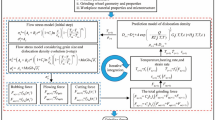Abstract
To achieve controlled stress grinding and controlled grinding of the depth of modificative layer, coupled analysis of grinding force and grinding heat is required. Therefore, this paper investigated grinding force and energy partition to lay a foundation for the coupled analysis. Firstly, a new grinding force model based on the analyses of grain trajectory and grain workpiece contact. In the modeling of grinding force, critical grain indention depths for plowing and cutting were calculated and the grinding force models of a single grain were established. This model can analyze the contributions of sliding, plowing, and cutting to total grinding forces. Secondly, an energy partition model was established based on the analyses of grain trajectory and grain workpiece contact. In the modeling of energy partition, the real contact area ratio and the grain contact radius were calculated. Finally, experiments were pursued to validate the grinding force model by comparing the experimental measurements to the theoretical results. Comparisons showed reasonable agreement quantitatively.
Similar content being viewed by others
References
Malkin S, Guo C (2007) Thermal analysis of grinding. CIRP Ann-Manuf Techn 56(2):760–782
Qin M, Ye B, Jia X, He A (2013) Experimental investigation of residual stress distribution in pre-stress cutting. Int J Adv Manuf Tech 65(1–4):355–361
Umbrello D, Jawahir IS (2009) Numerical modeling of the influence of process parameters and workpiece hardness on white layer formation in AISI 52100 steel. Int J Adv Manuf Tech 44(9–10):955–968
Marinescu ID, Hitchiner M, Uhlmann E, Rowe WB, Inasaki I (2007) Handbook of machining with grinding wheels. CRC Press, Boca Raton
Niu W, Xu Y (2003) Experimental study on grinding force of engineering ceramics in creep feed grinding. Diamond Abrasives Eng 2:24–27
Liu Q, Chen X, Wang Y, Gindy N (2008) Empirical modelling of grinding force based on multivariate analysis. J Mater Process Tech 203(1–3):420–430
Werner G (1978) Influence of work material on grinding forces. CIRP Ann-Manuf Techn 27(1):243–248
Malkin S, Guo C (2008) Grinding technology: theory and applications of machining with abrasives, 2nd edn. Industrial Press, New York
Li L, Fu J, Peklenik J (1980) A study of grinding force mathematical model. CIRP Ann-Manuf Techn 29(1):245–249
Patnaik Durgumahanti US, Singh V, Venkateswara Rao P (2010) A new model for grinding force prediction and analysis. Int J Mach Tool Manu 50(3):231–240
Badger JA, Torrance AA (2000) A comparison of two models to predict grinding forces from wheel surface topography. Int J Mach Tool Manu 40(8):1099–1120
Hecker RL, Liang SY, Wu XJ, Xia P, Jin DGW (2007) Grinding force and power modeling based on chip thickness analysis. Int J Adv Manuf Tech 33(5–6):449–459
Zhou X, Xi F (2002) Modeling and predicting surface roughness of the grinding process. Int J Mach Tool Manu 42(8):969–977
Xie Y, Williams JA (1996) The prediction of friction and wear when a soft surface slides against a harder rough surface. Wear 196(1–2):21–34
Younis M, Alawi H (1984) Probabilistic analysis of the surface grinding process. Trans CSME 8(4):208–213
Park HW, Liang SY (2008) Force modeling of micro-grinding incorporating crystallographic effects. Int J Mach Tool Manu 48(15):1658–1667
Park HW, Liang SY, Chen R (2007) Microgrinding force predictive modelling based on microscale single grain interaction analysis. Int J Manuf Technol Manage 12(1–3):25–38
Hadad M, Sadeghi B (2012) Thermal analysis of minimum quantity lubrication-MQL grinding process. Int J Mach Tool Manu 63:1–15
Rowe WB (2001) Thermal analysis of high efficiency deep grinding. Int J Mach Tool Manu 41(1):1–19
Ju Y (1997) Thermal aspects of grinding for surface integrity. Dissertation, Purdue University
Park HW, Liang SY (2009) Force modeling of microscale grinding process incorporating thermal effects. Int J Adv Manuf Tech 44(5–6):476–486
Author information
Authors and Affiliations
Corresponding author
Rights and permissions
About this article
Cite this article
Wang, D., Ge, P., Bi, W. et al. Grain trajectory and grain workpiece contact analyses for modeling of grinding force and energy partition. Int J Adv Manuf Technol 70, 2111–2123 (2014). https://doi.org/10.1007/s00170-013-5428-5
Received:
Accepted:
Published:
Issue Date:
DOI: https://doi.org/10.1007/s00170-013-5428-5




